Ann Lethbridge's Blog, page 32
January 24, 2011
Searching for Regency London
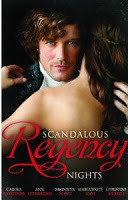 This is my latest release in the UK and I am so happy to be sharing it with some other authors. I love the cover and the title. Just to be clear this is a Mills and Boon Anthology containing the Undone short stories by several authors which are all available in ebook format from Harlequin and Mills and Boon and in all kinds of other formats for ebooks as single stories.
This is my latest release in the UK and I am so happy to be sharing it with some other authors. I love the cover and the title. Just to be clear this is a Mills and Boon Anthology containing the Undone short stories by several authors which are all available in ebook format from Harlequin and Mills and Boon and in all kinds of other formats for ebooks as single stories. If you prefer print books , then this will let you in on the action with these new stories for Harlequin and Mills. You will find it in the UK primarily, and you can Buy it from Amazon.co.UK

Returning to our topic, we are continuing our walk along the side of the Thames below London Bridge. This is of course the dock area. We are in Wapping. An area long known as being poor and crime ridden. This area is full of building used as warehouses for storing goods either to be shipped or coming into Britain. Many or most of them are now luxury dwelling.
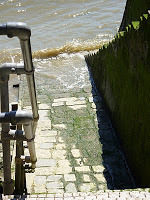
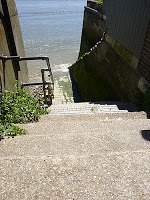
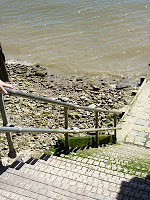
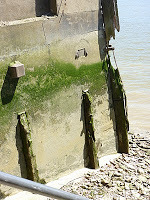 These pictures are taken of Wapping Old Stairs. As you can see these stairs lead down into the Thames.
These pictures are taken of Wapping Old Stairs. As you can see these stairs lead down into the Thames.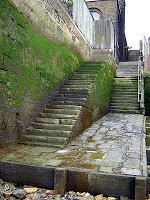 The Thames is tidal at this point and I think you can see quite clearly the high water mark on both the step and the concrete wall, which by the way supports the terrace where my guides and I had a very nice lunch and a cup of tea. There are older stairs on the right, but I was unable to access these, but here is a picture of them from Wikipedia that someone took without needing to get their feet wet.
The Thames is tidal at this point and I think you can see quite clearly the high water mark on both the step and the concrete wall, which by the way supports the terrace where my guides and I had a very nice lunch and a cup of tea. There are older stairs on the right, but I was unable to access these, but here is a picture of them from Wikipedia that someone took without needing to get their feet wet.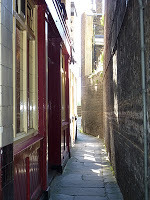
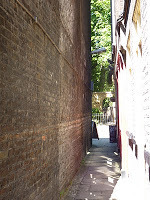 These pictures looks down the narrow alleyway that gives access to the stairs between the pub and the building beside it. The left towards the street and the right, obviously towards the river.
These pictures looks down the narrow alleyway that gives access to the stairs between the pub and the building beside it. The left towards the street and the right, obviously towards the river. In 1811, the horrific Ratcliff Highway murders took place at The Highway and Wapping Lane. I will post about this at some other time.
The Town of Ramsgate pub is the white building with red trim on wone side of the alley leading to the steps. While not the original pub, the name is as it was in the Regency and it was so named as a way of attracting the custom of Kentish fishermen who used to land their wares here.
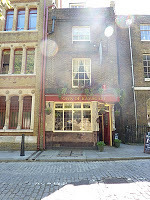 Some where near here was located Execution Dock where pirates met their end. Several pubs claim the honour but a rather unscientific survey leads me to believe it lay closest to the Town of Ramsgate. The final hangings were George Davis and William Watts charged with piracy and hung December 1830.
Some where near here was located Execution Dock where pirates met their end. Several pubs claim the honour but a rather unscientific survey leads me to believe it lay closest to the Town of Ramsgate. The final hangings were George Davis and William Watts charged with piracy and hung December 1830. And so we finish with a picture of the inn.
Until next time, Happy Rambles
Published on January 24, 2011 19:39
January 18, 2011
I can't remember how many times I have complained about G...
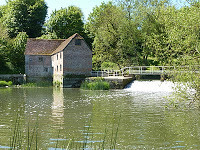 I can't remember how many times I have complained about Graffiti, but this past summer, I was enchanted to find some. Sounds very strange, I know, but to me this was special.
I can't remember how many times I have complained about Graffiti, but this past summer, I was enchanted to find some. Sounds very strange, I know, but to me this was special. I visited Sturminster Newton Town Mill and was fascinated to find that the mill dated from the eleventh century. The current building has two wings one dating from c. 1650 and the later part, jutting out into the River Stour was built in the late eighteenth century, and was originally a fulling mill used for the finishing of locally woven material known as 'Swanskin', a coarse, white woollen cloth or flannel produced for soldiers, sailors and Newfoundland fisherman. Ah a Canadian connection. The mill was thatched until 1862 and now is roofed with stone tiles.
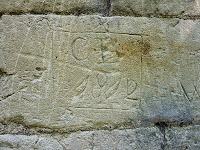
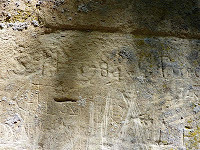 But to get to my topic. The south facing wall of the mill has some very nice graffiti, initials and dates from the late eighteenth and nineteens century. These initials are deeply carved in the south wall of the building on the bank. The first is S.N from 1874. He was in fact Samuel Newman, the miller at this time. The second is C.B from 1812.C.B also made an appearance in 1809 and he was Chas Baverstock, also a miller. A way to make sure you are remembered for a considerable period of time, even if it was for not having much work to do.
But to get to my topic. The south facing wall of the mill has some very nice graffiti, initials and dates from the late eighteenth and nineteens century. These initials are deeply carved in the south wall of the building on the bank. The first is S.N from 1874. He was in fact Samuel Newman, the miller at this time. The second is C.B from 1812.C.B also made an appearance in 1809 and he was Chas Baverstock, also a miller. A way to make sure you are remembered for a considerable period of time, even if it was for not having much work to do.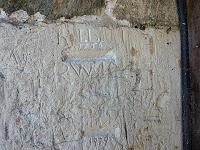
Not all graffiti is of the idle kind. If you can see on this next picture, there are deep grooves in this stone, which is situated in the doorway into the mill. These grooves represent the height of winter flooding. The highest was recorded in 1756, and the next highest in 1979. I was glad to see the tradition continued.l
I wonder if you can tell why no one wrote there name on this nearby bridge made of the same stone during a very similar time period.

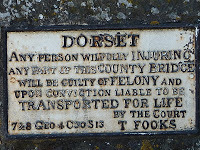
It might have something to do with this little sign which I found on many of the bridges in this county. Good old George IV.
Published on January 18, 2011 22:00
January 11, 2011
Searching for Regency London
First I wanted to offer my sympathy to all those readers and authors in the Brisbane area. I visited Australia two years ago and have friends there. I am devastated watching those news reports and my thoughts are with you all.
London

The next part of my journey involved the River Thames. An important highway, the City grew up beside it and around it. We walked from the Tower of London towards the docks.
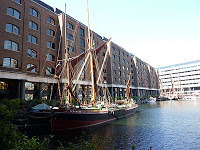 One of the first things my guide pointed out was a Thames Barge.
One of the first things my guide pointed out was a Thames Barge.
You can just see the red sails. Apparently they were not dyed red, but the preservative used on them turns them red.
Originally, Thames barges and lighters were rowed out from the docks from ships to large to tie up at the warves. They would bring the goods from ship to shore.
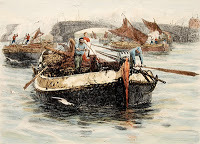
As time went on sails were added and their heyday was around 1900, there being about two thousand working on the river by that time.
This next picture is of Jacob's Island, which you may recall as the setting from Dicken's Oliver Twist
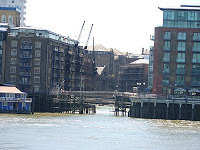 What you are looking at here is the point at which the River Neckinger meets the Thames at St. Saviour's Dock. While it is now a desirable area, it was once notoriously squalid.
What you are looking at here is the point at which the River Neckinger meets the Thames at St. Saviour's Dock. While it is now a desirable area, it was once notoriously squalid.
The following pictures from earlier times will help set the picture I think.
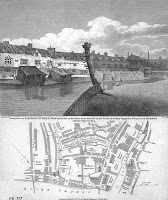
This picture from wikipedia shows Neckinger River in 1813, which by the way my guide told me was the term for a noose for a river pirate. Further research revealed the river is believed to be named from the term "Devil's neckcloth. Until the eighteenth century Thames pirates were excuted at what was then called Neckinger Wharf near the mouth of the inlet. The corpses were displayed further downstream as a deterrent.
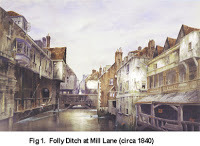 Particularly interesting is the attached map. Hard to read, but fascinating. If you look closely you can make out Mill Street running parallel and one block to the left from the dock. Which brings us to the next picture, circa1840.
Particularly interesting is the attached map. Hard to read, but fascinating. If you look closely you can make out Mill Street running parallel and one block to the left from the dock. Which brings us to the next picture, circa1840.
Folly ditch. Man made tidal ditches had surrounded Jacobs Island in earlier centuries, a way of getting goods to wharehouses. Over the years they were filled in leaving them land locked with all the attendant evils of stagnant water.
If you want to know more about Jacob's Island, earlier and later than the Regency, I found this website to be fascinating.
Some books I found useful in preparing for my walks around London.
Secret London: Exploring the Hidden City, With Original Walks And Unusual Places to Visit

A. to Z. of Regency London At Amazon.com
Or Search for the A-Z of Regency London at Abebooks where you might well find a cheaper version
More to come on the River Thames and its History next time. Until then, Happy Rambles.
London

The next part of my journey involved the River Thames. An important highway, the City grew up beside it and around it. We walked from the Tower of London towards the docks.
 One of the first things my guide pointed out was a Thames Barge.
One of the first things my guide pointed out was a Thames Barge. You can just see the red sails. Apparently they were not dyed red, but the preservative used on them turns them red.
Originally, Thames barges and lighters were rowed out from the docks from ships to large to tie up at the warves. They would bring the goods from ship to shore.

As time went on sails were added and their heyday was around 1900, there being about two thousand working on the river by that time.
This next picture is of Jacob's Island, which you may recall as the setting from Dicken's Oliver Twist
 What you are looking at here is the point at which the River Neckinger meets the Thames at St. Saviour's Dock. While it is now a desirable area, it was once notoriously squalid.
What you are looking at here is the point at which the River Neckinger meets the Thames at St. Saviour's Dock. While it is now a desirable area, it was once notoriously squalid.The following pictures from earlier times will help set the picture I think.

This picture from wikipedia shows Neckinger River in 1813, which by the way my guide told me was the term for a noose for a river pirate. Further research revealed the river is believed to be named from the term "Devil's neckcloth. Until the eighteenth century Thames pirates were excuted at what was then called Neckinger Wharf near the mouth of the inlet. The corpses were displayed further downstream as a deterrent.
 Particularly interesting is the attached map. Hard to read, but fascinating. If you look closely you can make out Mill Street running parallel and one block to the left from the dock. Which brings us to the next picture, circa1840.
Particularly interesting is the attached map. Hard to read, but fascinating. If you look closely you can make out Mill Street running parallel and one block to the left from the dock. Which brings us to the next picture, circa1840.Folly ditch. Man made tidal ditches had surrounded Jacobs Island in earlier centuries, a way of getting goods to wharehouses. Over the years they were filled in leaving them land locked with all the attendant evils of stagnant water.
If you want to know more about Jacob's Island, earlier and later than the Regency, I found this website to be fascinating.
Some books I found useful in preparing for my walks around London.
Secret London: Exploring the Hidden City, With Original Walks And Unusual Places to Visit


A. to Z. of Regency London At Amazon.com

Or Search for the A-Z of Regency London at Abebooks where you might well find a cheaper version
More to come on the River Thames and its History next time. Until then, Happy Rambles.
Published on January 11, 2011 07:51
January 2, 2011
Happy New Year
Published on January 02, 2011 08:08
December 22, 2010
The Winner
Happy Holidays
of my portion of the Holiday Contest is Sheila Gallagher. She entered through my face book page. http://www.facebook.com/pages/Ann-Lethbridge/74797436859 The number was drawn randomly from the full list of all the names, those who liked, those who commented on facebook and those who commented on the blog. I wanted each and everyone of you to win, but unfortunately only one person can.
Thank you for entering. It has been wonderful to meet so many readers of Historical and Regency fiction who are new to me. Some of you even signed up for my newsletter, so I am glad we will have an ongoing relationship. Isn't that the nicest thing about meeting new friends, knowing they will be part of your future, even if it is only on line?
Thank you all for making this contest such a pleasure. I had so much fun reading all the names and all the comments yesterday.
Have a safe and wonderful Holiday. Good luck on this the last day of the contest,
 My next post will probably be next week, as I really must get some baking done and there is a little matter of a story awaiting my attention.
My next post will probably be next week, as I really must get some baking done and there is a little matter of a story awaiting my attention.Until next time, Happy Rambles.
Published on December 22, 2010 05:55
December 20, 2010
Holiday Contest
Post your Contest answer here!


What is the first name of Alice's best friend? She will be appearing in the book I am working on now. You will need to go to my website to find the answer -- unless you read the book!
Post it sometime during December 21 to be included in my draw and the Grand Prize Draw. I will post the winner's names on Facebook and on this blog.
Good Luck


What is the first name of Alice's best friend? She will be appearing in the book I am working on now. You will need to go to my website to find the answer -- unless you read the book!
Post it sometime during December 21 to be included in my draw and the Grand Prize Draw. I will post the winner's names on Facebook and on this blog.
Good Luck
Published on December 20, 2010 21:01
December 15, 2010
Regency Food
It has been a while since we did anything on food so I thought you might like a change. It could be that will all the festivities planned for the next little while, I have food on my mind.
 While I know lots about meat, I thought I might do something of vegetables. I found several recipes for a vegetable called a cardon in French, or in English a cardoon. It went "out of fashion" in the late 1800's.
While I know lots about meat, I thought I might do something of vegetables. I found several recipes for a vegetable called a cardon in French, or in English a cardoon. It went "out of fashion" in the late 1800's.
It is new to me, but it is an artichoke thistle, related to the globe artichoke and has an artichoke like flavour. Since it has spines, care is needed.
The following recipe from 1822 would have been used as a second course dish.
Cardons a la Espagnole
This dish is the foremost of all the entremets of vegetables and requires great attention and no small share of skill. It is not much relished in England but in France it was held in the highest estimation.
In the first place you must select a few heads of cardons all very white. Cut each leaf into slices of six inches long with the exception however of those that are hollow which are tough and thready. Beard them of their prickles and blanch them by putting the thickest leaves into boiling water. When you have given these a few boils put in the leaves of the heart, turn the middle stalks into large olives and blanch them likewise.
Then try a piece in cold water to see whether the slime which is on the surface will come off by rubbing If so take them off the fire immediately and throw them into cold water as they are done enough or you may cool the boiling water by pouring cold into it till you are able to bear your hand in it to rub off all the slime.
This being done throw the cardons into a blanc, give them a single boil and leave them in the blanc. Whenever you wish to use them, drain a sufficient quantity. Pare both extremities and mark them in a stew pan with four spoonfuls of Espagnole and four spoonfuls of consomme a little salt and a little sugar. Let them boil over a sharp fire that they may not be done too much be sure to skim off all the fat.
Dish them nicely. Strain the sauce through a tammy before you mask (cover) them. Send them up to table quite hot with a cover over them to prevent their getting dry
Espagnole is a sauce, created this way. Besides some slices of ham put into a stew pan some slices of veal. Moisten the same as for the coulis sweat them in the like manner let all the glaze go to the bottom and when of a nice red colour moisten with a few spoonfuls of first consomme to detach the glaze then pour in the coulis. Let the whole boil for half an hour that you may be enabled to remove all the fat. Strain it through a clean tammy. Remember always to put into your sauces some mushrooms with a bunch of parsley and green onions.
Other suggested sauces were marrow (as in bone), veloute, and sauce blanche. Take your pick.
Interesting, but not something I plan to rush out and buy from the grocery store. Next time we will try something a little less exotic.
Until then Happy Rambles
 While I know lots about meat, I thought I might do something of vegetables. I found several recipes for a vegetable called a cardon in French, or in English a cardoon. It went "out of fashion" in the late 1800's.
While I know lots about meat, I thought I might do something of vegetables. I found several recipes for a vegetable called a cardon in French, or in English a cardoon. It went "out of fashion" in the late 1800's.It is new to me, but it is an artichoke thistle, related to the globe artichoke and has an artichoke like flavour. Since it has spines, care is needed.
The following recipe from 1822 would have been used as a second course dish.
Cardons a la Espagnole
This dish is the foremost of all the entremets of vegetables and requires great attention and no small share of skill. It is not much relished in England but in France it was held in the highest estimation.
In the first place you must select a few heads of cardons all very white. Cut each leaf into slices of six inches long with the exception however of those that are hollow which are tough and thready. Beard them of their prickles and blanch them by putting the thickest leaves into boiling water. When you have given these a few boils put in the leaves of the heart, turn the middle stalks into large olives and blanch them likewise.
Then try a piece in cold water to see whether the slime which is on the surface will come off by rubbing If so take them off the fire immediately and throw them into cold water as they are done enough or you may cool the boiling water by pouring cold into it till you are able to bear your hand in it to rub off all the slime.
This being done throw the cardons into a blanc, give them a single boil and leave them in the blanc. Whenever you wish to use them, drain a sufficient quantity. Pare both extremities and mark them in a stew pan with four spoonfuls of Espagnole and four spoonfuls of consomme a little salt and a little sugar. Let them boil over a sharp fire that they may not be done too much be sure to skim off all the fat.
Dish them nicely. Strain the sauce through a tammy before you mask (cover) them. Send them up to table quite hot with a cover over them to prevent their getting dry
Espagnole is a sauce, created this way. Besides some slices of ham put into a stew pan some slices of veal. Moisten the same as for the coulis sweat them in the like manner let all the glaze go to the bottom and when of a nice red colour moisten with a few spoonfuls of first consomme to detach the glaze then pour in the coulis. Let the whole boil for half an hour that you may be enabled to remove all the fat. Strain it through a clean tammy. Remember always to put into your sauces some mushrooms with a bunch of parsley and green onions.
Other suggested sauces were marrow (as in bone), veloute, and sauce blanche. Take your pick.
Interesting, but not something I plan to rush out and buy from the grocery store. Next time we will try something a little less exotic.
Until then Happy Rambles
Published on December 15, 2010 22:00
December 14, 2010
Contest
 Now you have all heard about the hiding of gifts inside a Christmas pudding, right? No? In the early days it would be a silver threepence, or some other small silver coin. My Christmas pudding is a cyber one.
Now you have all heard about the hiding of gifts inside a Christmas pudding, right? No? In the early days it would be a silver threepence, or some other small silver coin. My Christmas pudding is a cyber one.Enter the amazing contest we Harlequin Historical authors have going on at the moment and have a chance to win your choice of one of my books as well all kinds of other amazing prizes from twenty-tow historical authors You just need to go to my website and follow the instructions, as well as have fun.
Until next time, happy hunting!
Published on December 14, 2010 09:56
December 9, 2010
Regency London ~ My search
Contest:Enter to win a Kindle 3G! your choice of one of my books and many other prize. Go to annlethbridge.com
Regency London
My next day in London was a biggie. Talk about ramble. I walked miles. Looking back at my notes and plans, I now remember how worried I was about the volcano in Iceland. Anyone remember that? I was on tenterhooks for weeks wondering if we would actually make it across the pond. Oh, now we have taken a side turn. Back onto the main path. That particular day, I took the underground to Tower station, where I met my fellow ramblers. Our first stop was a church
All Hallows by the Tower
London has many many churches, but this one calls itself the oldest one in the city of London. I am hedging my bets a bit here, because I did not do the research and merely accept what they say.
 The Saxon Abbey of Barking founded the church of All Hallows by the Tower in 675 AD. An arch from the original Saxon church remains. Beneath the arch is a Roman pavement, discovered in 1926, evidence of city life on this site for the best part of two thousand years.Following their execution on Tower Hill, numerous beheaded bodies were brought into the church including those of Thomas More, Bishop John Fisher and Archbishop Laud. William Penn, founder of Pennsylvania, was baptised in the church and educated in the schoolroom (now the Parish Room). In 1666 the Great Fire of London started in Pudding Lane, a few hundred yards from the church, and All Hallows survived through the efforts of Admiral Penn, William Penn's father. Apparently Samuel Pepys watched the fire from its tower.John Quincy Adams, sixth president of the USA, was married in All Hallows in 1797.
The Saxon Abbey of Barking founded the church of All Hallows by the Tower in 675 AD. An arch from the original Saxon church remains. Beneath the arch is a Roman pavement, discovered in 1926, evidence of city life on this site for the best part of two thousand years.Following their execution on Tower Hill, numerous beheaded bodies were brought into the church including those of Thomas More, Bishop John Fisher and Archbishop Laud. William Penn, founder of Pennsylvania, was baptised in the church and educated in the schoolroom (now the Parish Room). In 1666 the Great Fire of London started in Pudding Lane, a few hundred yards from the church, and All Hallows survived through the efforts of Admiral Penn, William Penn's father. Apparently Samuel Pepys watched the fire from its tower.John Quincy Adams, sixth president of the USA, was married in All Hallows in 1797.
After the bombings of World War II, only the tower remains of that old church. The church continues its old medieval custom of "beating the bounds" basically walking the boundaries of the parish and whacking the ground along the line at intervals with sticks. I guess this prevents some other church from claiming their parishioners? Since one of the boundaries actually runs down the center of the River Thames they all get on a boat to observe this part of the custom. Now I do not know if they did this during the Regency, or if this was revived more recently, but it is just interesting.
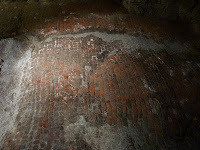 Certainly the Church was there, beside the Tower of London, during our time and during the centuries before.
Certainly the Church was there, beside the Tower of London, during our time and during the centuries before.
This picture shows part of the Roman street found beneath the Church in the early 20th century.
Don't forget to look out for my new short story e-book Undone out this month.
Unmasking Lady Innocent
This day was a long one and there is much more to come. Until then, Happy Rambles.
Regency London
My next day in London was a biggie. Talk about ramble. I walked miles. Looking back at my notes and plans, I now remember how worried I was about the volcano in Iceland. Anyone remember that? I was on tenterhooks for weeks wondering if we would actually make it across the pond. Oh, now we have taken a side turn. Back onto the main path. That particular day, I took the underground to Tower station, where I met my fellow ramblers. Our first stop was a church
All Hallows by the Tower
London has many many churches, but this one calls itself the oldest one in the city of London. I am hedging my bets a bit here, because I did not do the research and merely accept what they say.
 The Saxon Abbey of Barking founded the church of All Hallows by the Tower in 675 AD. An arch from the original Saxon church remains. Beneath the arch is a Roman pavement, discovered in 1926, evidence of city life on this site for the best part of two thousand years.Following their execution on Tower Hill, numerous beheaded bodies were brought into the church including those of Thomas More, Bishop John Fisher and Archbishop Laud. William Penn, founder of Pennsylvania, was baptised in the church and educated in the schoolroom (now the Parish Room). In 1666 the Great Fire of London started in Pudding Lane, a few hundred yards from the church, and All Hallows survived through the efforts of Admiral Penn, William Penn's father. Apparently Samuel Pepys watched the fire from its tower.John Quincy Adams, sixth president of the USA, was married in All Hallows in 1797.
The Saxon Abbey of Barking founded the church of All Hallows by the Tower in 675 AD. An arch from the original Saxon church remains. Beneath the arch is a Roman pavement, discovered in 1926, evidence of city life on this site for the best part of two thousand years.Following their execution on Tower Hill, numerous beheaded bodies were brought into the church including those of Thomas More, Bishop John Fisher and Archbishop Laud. William Penn, founder of Pennsylvania, was baptised in the church and educated in the schoolroom (now the Parish Room). In 1666 the Great Fire of London started in Pudding Lane, a few hundred yards from the church, and All Hallows survived through the efforts of Admiral Penn, William Penn's father. Apparently Samuel Pepys watched the fire from its tower.John Quincy Adams, sixth president of the USA, was married in All Hallows in 1797. After the bombings of World War II, only the tower remains of that old church. The church continues its old medieval custom of "beating the bounds" basically walking the boundaries of the parish and whacking the ground along the line at intervals with sticks. I guess this prevents some other church from claiming their parishioners? Since one of the boundaries actually runs down the center of the River Thames they all get on a boat to observe this part of the custom. Now I do not know if they did this during the Regency, or if this was revived more recently, but it is just interesting.
 Certainly the Church was there, beside the Tower of London, during our time and during the centuries before.
Certainly the Church was there, beside the Tower of London, during our time and during the centuries before.This picture shows part of the Roman street found beneath the Church in the early 20th century.
Don't forget to look out for my new short story e-book Undone out this month.
Unmasking Lady Innocent

This day was a long one and there is much more to come. Until then, Happy Rambles.
Published on December 09, 2010 06:01
December 5, 2010
Regency Fashion for December
Just a quick reminder about the Holiday Contest on my website.
Our fashion article today is not what you would call cheerful but the description is so detailed I thought you would like it.
Princess Charlotte of Wales died November 6 1817 and Mourning Dress was still being worn in December as can be seen from this plate. The Princess was very popular and I think this would have been important to many people at this time
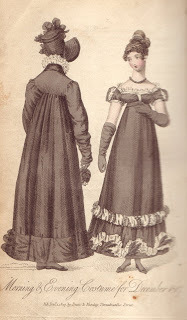
The Walking Dress
Plain round dress, composed of black bombazeen, the body is made up to the throat, and tight to the shape. Plain long sleeves with white crape weepers. The skirt is finished round the bottom by a number of black crape rouleaus. Over this dress is worn a pelisse of black Levantine, open in front, and wrapping a little to one side. The waist is very short, and the back is quite plain. There is a small square collar which supports a very full ruff composed of white crape. The collar, fronts, and bottom of the dress, ar finished by a broad trimming of black crape, which is laid on very full. Plain long sleeves, finished at the wrist with black crape to correspond: the upper part of the sleeve is full, but it is tight towards the wrist. Head-dress, a small French bonnet composed of black Leghorn. The edge of the front is ornamented by a rouleau of black crape; two rouleaus ornament the top of the crown; and one very broad one goes round the bottom of it. A black crape band ties it under the chin; and a full bunch of artificial flowers, composed also of black crape, ornaments it on one side. Black shamoy gloves and black shoes.
The Evening Dress
A black crape frock over a black sarsnet slip: the body is cut very low all round the bust, and very short in the waist. The sleeve is very short and full. A narrow white crape trimming, of a novel description goes round the bust, and both the body and sleeves are interspersed in a new style, with either black or white crape. The skirt is of easy fullness; it is finished round the bottom by a broad trimming of either black or white crape disposed in festoons, and interspersed with cypress leaves, composed of black crape. This is surmounted by a broad rouleau of either black or white crape, round which is twined a double row of polished jet beads. The hair is dressed high behind, and in light curls on the forehead; it is ornamented only be an elegant jet comb. Necklace and ear-rings of jet. Gloves of black shamoy leather; plain black silk shoes.
The use of jet for ornament is typical of this era for morning. I find the use of white as trim very interesting.
That is all from me on this occasion. In the new year, we will be looking at our fashions from a different angle.
Until next time, Happy Rambles.
Our fashion article today is not what you would call cheerful but the description is so detailed I thought you would like it.
Princess Charlotte of Wales died November 6 1817 and Mourning Dress was still being worn in December as can be seen from this plate. The Princess was very popular and I think this would have been important to many people at this time

The Walking Dress
Plain round dress, composed of black bombazeen, the body is made up to the throat, and tight to the shape. Plain long sleeves with white crape weepers. The skirt is finished round the bottom by a number of black crape rouleaus. Over this dress is worn a pelisse of black Levantine, open in front, and wrapping a little to one side. The waist is very short, and the back is quite plain. There is a small square collar which supports a very full ruff composed of white crape. The collar, fronts, and bottom of the dress, ar finished by a broad trimming of black crape, which is laid on very full. Plain long sleeves, finished at the wrist with black crape to correspond: the upper part of the sleeve is full, but it is tight towards the wrist. Head-dress, a small French bonnet composed of black Leghorn. The edge of the front is ornamented by a rouleau of black crape; two rouleaus ornament the top of the crown; and one very broad one goes round the bottom of it. A black crape band ties it under the chin; and a full bunch of artificial flowers, composed also of black crape, ornaments it on one side. Black shamoy gloves and black shoes.
The Evening Dress
A black crape frock over a black sarsnet slip: the body is cut very low all round the bust, and very short in the waist. The sleeve is very short and full. A narrow white crape trimming, of a novel description goes round the bust, and both the body and sleeves are interspersed in a new style, with either black or white crape. The skirt is of easy fullness; it is finished round the bottom by a broad trimming of either black or white crape disposed in festoons, and interspersed with cypress leaves, composed of black crape. This is surmounted by a broad rouleau of either black or white crape, round which is twined a double row of polished jet beads. The hair is dressed high behind, and in light curls on the forehead; it is ornamented only be an elegant jet comb. Necklace and ear-rings of jet. Gloves of black shamoy leather; plain black silk shoes.
The use of jet for ornament is typical of this era for morning. I find the use of white as trim very interesting.
That is all from me on this occasion. In the new year, we will be looking at our fashions from a different angle.
Until next time, Happy Rambles.
Published on December 05, 2010 22:00




